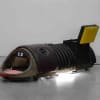Neïl Beloufa: Global Agreement
In an interview for the 2018 exhibition of Global Agreement, Neïl Beloufa remarks, “the idea of the show is that the world has never been this globalized. People have never been this connected.” And yet, as the artist counters, war, militarization, and identitarian divide are omnipresent in societies across the globe–their chokehold on channels of communication even more so.
Beloufa is no stranger to concepts as vast and nebulous as these. They feature centrally in his multimedia practice, whose witty reliefs and circuitous electricals often allegorize structures of power. And in the wake of a global pandemic, amid 2021’s hyper-dependency on digital interfaces (re: Zoom), Beloufa’s installation has its finger on the pulse of our most contemporary communications. Global Agreement was first shown at the Schirn Künsthalle Frankfurt, and then at 2019’s Venice Biennale. The exhibition examines modern warfare from the vantage of its direct personnel. Beloufa worked closely with soldiers stationed around the world, extracting from their testimonies a characterization of war that resists accounts from Hollywood or the army itself. Instead, the image he presents is atomized, obscured through digital platforms, and reconstructed with startling new prescience. Merging interactive architectures with the artist’s eagle-eyed vigilance toward the levers of power, Global Agreement puts forward a compelling allegory for the paradox of globalization.
Upon first encounter, Beloufa’s multimedia benches reveal a blend of ergonomic cues. Ambiguous rope suspensions and slick vinyl upholstery suggest a system at once gymnastic, orthopedic, and unmistakably institutional. The rote, modular design of the benches evokes the indelible sense that they’re involved in some kind of “training.” Approaching the LCD displays, the seated viewer finds a vertical apparatus extending from atop each bench, equipped with a viewfinder. Undecided headrest or restraint, the apparatus becomes the physical mediator of Beloufa’s video works. These feature Skype interviews of soldiers and military staff, many of whom have large social media followings. Interviews are conducted exclusively online using an array of digital aliases. Footage is then edited to exclude Beloufa’s questioning, and to include only the interviewees’ remarks–often mundane, sometimes deeply personal. The effect–transforming the viewer from third-person onlooker to direct participant in an increasingly genuine social interaction–is a conversational dynamic wavering between anonymity and intimate confessional. A dire sense of unease, even discomfort pervades each interview. This belongs largely to the work’s uncanny glimpses of state-sanctioned violence operating in real time, and through real-world agents. One soldier, her face illuminated by the garish blue cast of the computer monitor, confides: “I know it’s gonna sound funny, but I don’t like fighting...the Navy’s mission is really just to make the world a better place...a global force for good, as they say...”
Saddled across Beloufa’s cloying pink bench cushions, the viewer is situated not within an armed conflict, but beside the people through whom these immense and shadowy global apparatuses (war, economy, communication, etc.) actually take place. That is to say, beside ordinary people. Beloufa’s composition abstracts the facts of war through the personalities and personal lives of those immediately involved. The reconstituted image is one ultimately more faithful to the relationship between transnational power structures and their actors. “You talk to someone, you hear someone talking about love, his life...and so in the sculptures,” Beloufa notes, “you’re in front of your own empathy.” In this sense, the arrangement is not unlike our contemporary social media, behind whose retina screens and familiar faces lurk similar political agendas.
Framing the perimeter of the exhibition are a selection of Beloufa’s polychrome light boxes. Their translucent mosaics of quaint floral imagery jar against welded steel underpinnings, consumer refuse, and the conspicuous electrical cords that anchor each work to an outlet. In conversation with the video installation, these works offer yet another keen metaphor for the new world order’s vague and far-reaching interruptions to modern life.
Neïl Beloufa (born 1985, Paris, France) is a French-Algerian artist who lives and works in Paris. He studied at École Nationale Supérieure des Beaux-Arts and at École Nationale Supérieure des Arts Décoratifs, Paris; California Institute of the Arts, Valencia, USA; Cooper Union, New York; and Fresnoy – National Contemporary Arts Studio, Tourcoing, France. Beloufa has presented recent solo exhibitions at François Ghebaly, Los Angeles (2021); Pirelli HangarBicocca (2020), Schirn Künsthalle, Frankfurt (2018); Palais de Tokyo, Paris (2018); Pejman Foundation, Tehran (2017); K11 Art Foundation, Shanghai (2017); Museum of Modern Art, New York (2016); and Schinkel Pavillon, Berlin (2015). He participated in the Venice Biennale in 2013 and 2019, the Biennale of Contemporary Art in Shanghai in 2014, and the Lyon Biennale of Contemporary Art in 2013.






